39 -FU2 Chemo and Scanxiety
12 October 2022
Ooh, I didn’t realise how long it’s been since my last post back in August. They say time flies when you’re enjoying yourself…
Well, I wouldn’t quite call it ‘enjoying myself’, as I’ve been on Chemotherapy continuously for the past 10 weeks. In fairness it hasn’t been so bad for me – I’ve had few side-effects, but still got all my hair and appetite.
Of course, it’ll take much, much more to stop me eating than a few doses of chemo!
I’m absolutely convinced that the Beerotherapy has helped, if only that following high doses of beer, I seem to forget about what’s up with me.
I might have also forgotten to tell my GP about the beer. She spoke to me a couple of weeks ago and says I’m ‘defying science’ when considering my treatment regime. I think my body has defied science for many years really, but I’m taking this latest medical opinion wholeheartedly!
As I write this, I’ve just started my sixth cycle of chemo. Each cycle is 3 weeks and goes something like:
Week 1 (Mondays) - I get two infusions in hospital – Carboplatin and Fluoroucil 5FU along with anti-sickness medication and Dexamethasone steroid, which I also get tablets to take at home.
Week 2 – No new infusions or drugs, just feel the treatments working (feeling of fatigue and occasional sickness), along with forgetfulness which I blame on the chemo, but really I suppose it’s a function of age ☹
Week 3 – This is a so-called recovery week where my body regains its white blood cells and has increased immunity from infection.
At the end of Week 3, I’m back in hospital on the Friday for blood samples and the consultant checks that I’m fit and well enough to start the poisoning cycle again on the following Monday!
So, being in my sixth cycle of chemo, I think this is the last for now. The regimen calls for six cycles of 3 weeks (18 weeks total) and then evaluation of the treatment and its success (or not) of slowing the growth of existing tumours and any spread to further parts of the body.
Evaluation is done by taking CT scans, which I had at the end of September and then my consultant Dr Grant, decides on the next steps. This could be more of the same to follow-on, a break in chemo and then restart when my body recovers or a completely different treatment.
That was a simple enough paragraph to write, but the actuality is more complex and frustrating.
It seems that post-covid the NHS are under pressure to increase scanning for many patients, especially those with cancer (or initial scans to find out) – and this appears to be happening 7 days a week here. This is the good news.
The not so good news is that the next step in the chain is the ‘Radiologist Principal Interpreter’ (as they’re called here in Gloucestershire), to write a report detailing what the scans show. It is this report that goes to my consultant for him to decide on prognosis and treatment.
But now we’re in a position that the Radiologists are completely overwhelmed with the higher volume of scans to interpret, meaning there are lengthy delays in getting these to the consultant.
Which is where I’m at right now – with no report available after almost 3 weeks and not knowing how I’m doing, or what happens next.
Hoping to know more soon(ish) and write an update on this in a week or so.
Anyway – back to the chemotherapy.
I’ve had a few people (via my blog and social media) ask me for a bit more detail about the regimen I’m on. The how and why of this combination of Carboplatin and Fluorouracil 5FU is infused.
So here goes my understanding:
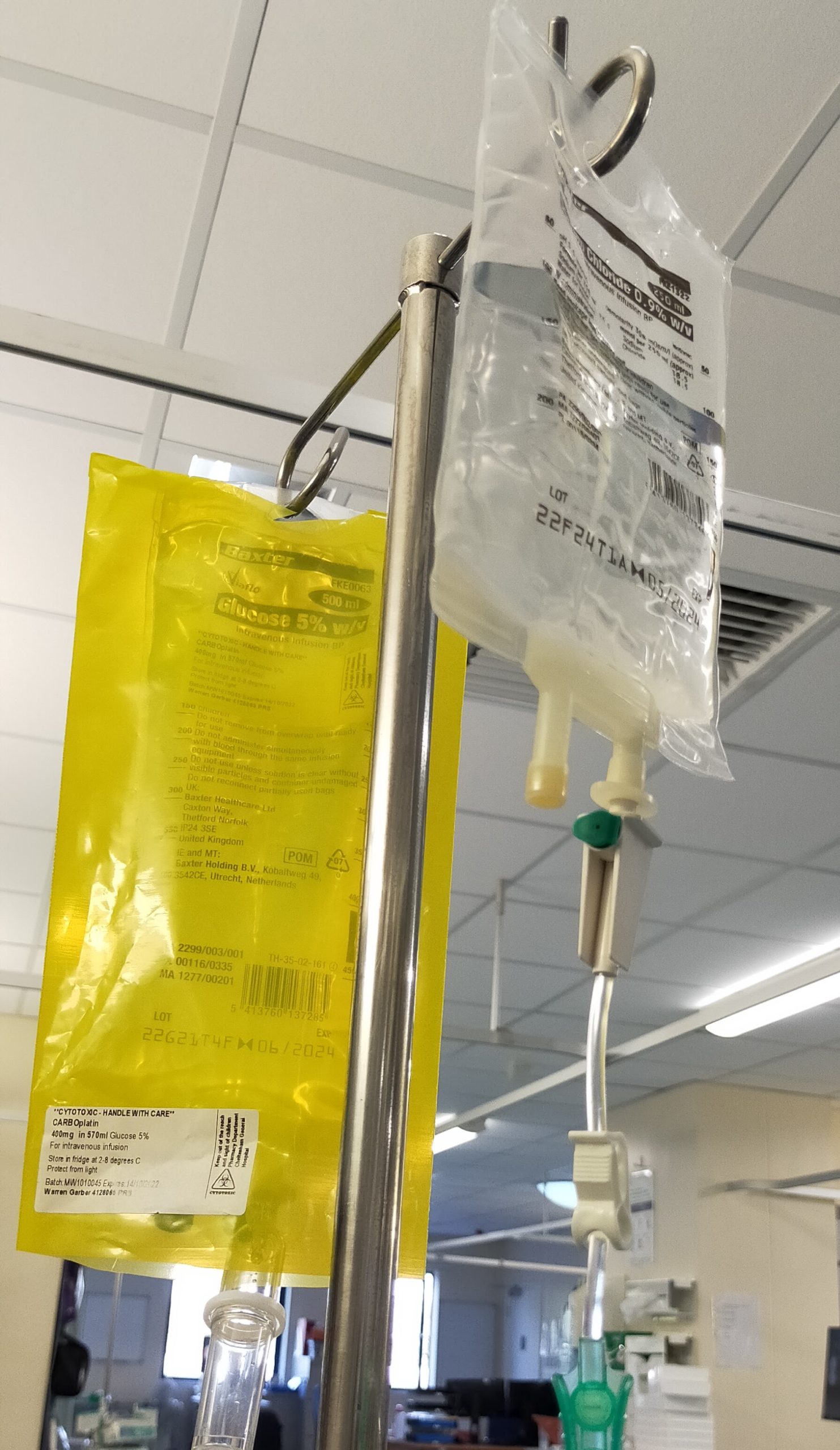
Normally the go-to chemotherapy for my type of primary and therefore secondary cancer, officially known as ‘head and neck squamous cell carcinoma’ is a long-standing treatment called Cisplatin. It’s a platinum-based drug and very toxic – especially to kidneys. And it was determined early on in the process that my kidneys might be damaged, to the point that I’d be worse off with renal failure than the cancer!
In fairness, my poor old kidneys have worked pretty dammed hard, filtering probably far too much alcohol over many sessions. Seemed great at the time though!
So, Cisplatin definitely isn’t for me. The alternative is two drugs, that when combined attack the cancer cells, but with lower risk to my kidneys. That’s not to say they’re milder – I understand that it’s more like 1+1=3, in that the combinations works better than either drug given in isolation.
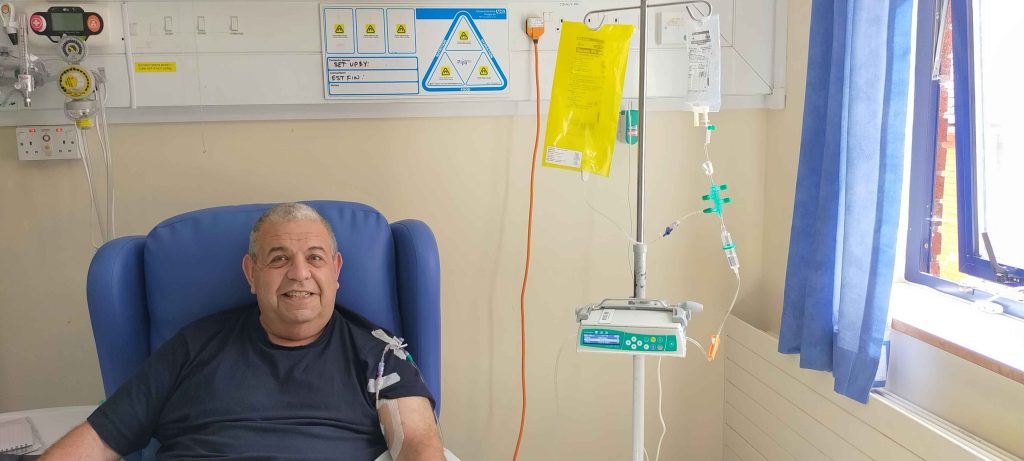
For the past so many Mondays, I’m in Prescott Ward at Cheltenham Oncology Centre. It’s a day patient ward for cancer treatment infusions, and we’re in chairs rather than beds. My time there is around 1.5 to 2 hours. The staff – as ever – are amazing and highly professional – even more so because of the Cytotoxic (toxic to cells) drugs they have to handle and dispense. And of course, helping patients with varying stages of cancer.
It starts with a hook-up of a quarter litre of saline, which goes into my PICC line via a pump. This is just to give me a bit more fluid.
Then I get a dose of steroid (Dexamethasone) through the line to help my body resist the immediate effect of the chemo – then finally the Carboplatin is added to my line. It takes exactly 30 minutes for the 570ml of Carboplatin to be administered. That equates to a dose rate of 1140ml per hour.
Following that, the second infusion is the Fluorouracil 5FU. This is highly concentrated and quite strong. So much so that it takes 96 hours to infuse 192ml of 5FU. This equates to a dose rate of just 2ml/hour.
Back in the day patients would be in hospital for 4 days (96 hours) to receive this continuous infusion. But nowadays I have a ‘Baxter Infusor Pump attached to me and my PICC line and it stays connected for the full 96 hours – day and night. I did touch on this in a previous post – but now I’ve detailed some more by request.
The Baxter Infusor elsotomeric pump, to give its full name is known as an OPAT device. OPAT stands for Outpatient parenteral antimicrobial therapy, which simply means self-administration of complex drugs in the community (at home), under telephone helpline supervision.
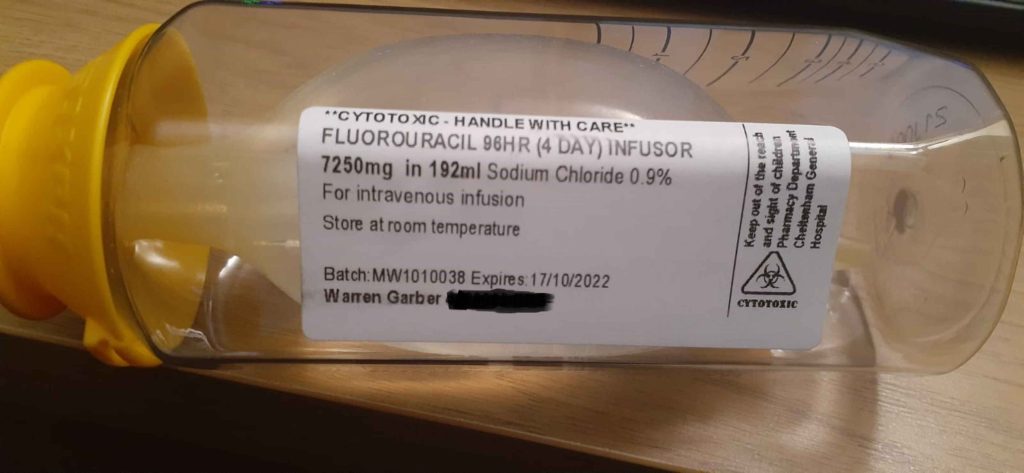
The ‘pump’ itself is a work of genius. It doesn’t have any metal moving parts or electrics. Instead, it has a pressurised balloon filled with the 5FU chemo.
This is inside a sealed container and connected to a fine flexible pipe of around 90cm long, which attaches to my PICC line. By day I wear it in a pouch attached to my belt.
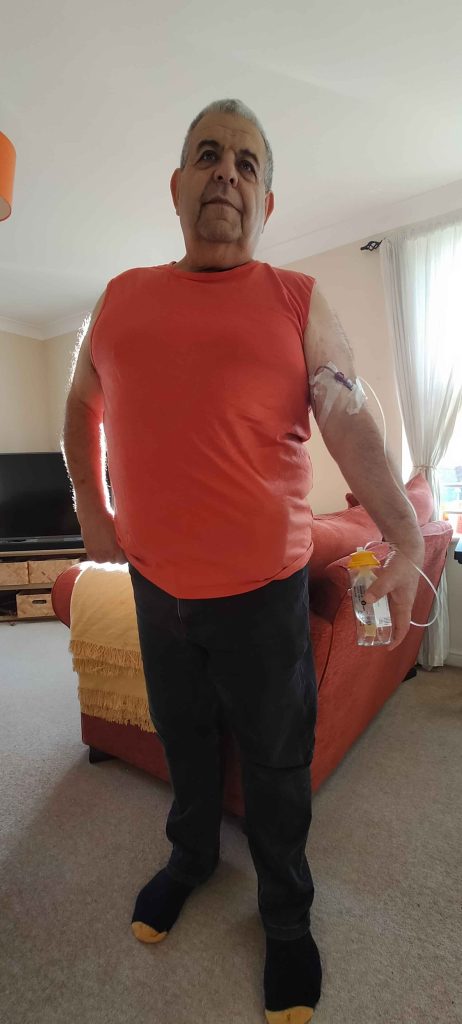
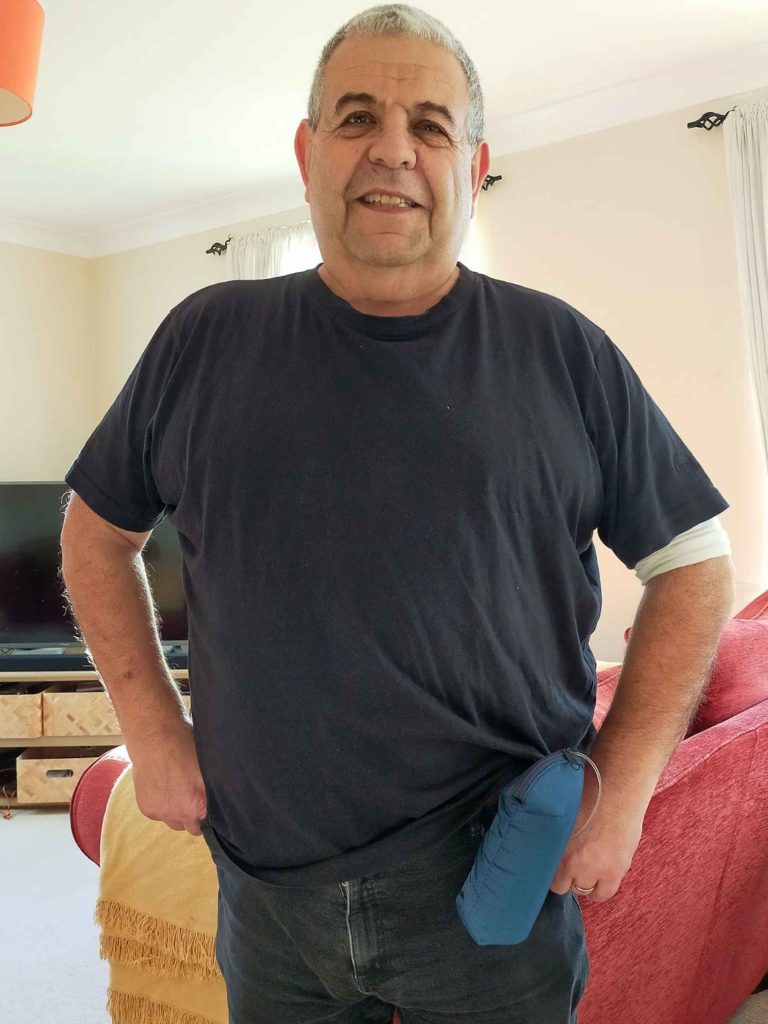
At night, the pump is placed behind my pillow – but with only a short pipe (the pump that is), I have to be careful about how I move!
The ‘pump’ action is a combination of the pressurised balloon expelling the chemo through the fine tube and a flow regulator that is attached to the PICC line. Between them, they rely on body heat and I suppose a bit of capillary action to keep the flow moving at the correct dose.
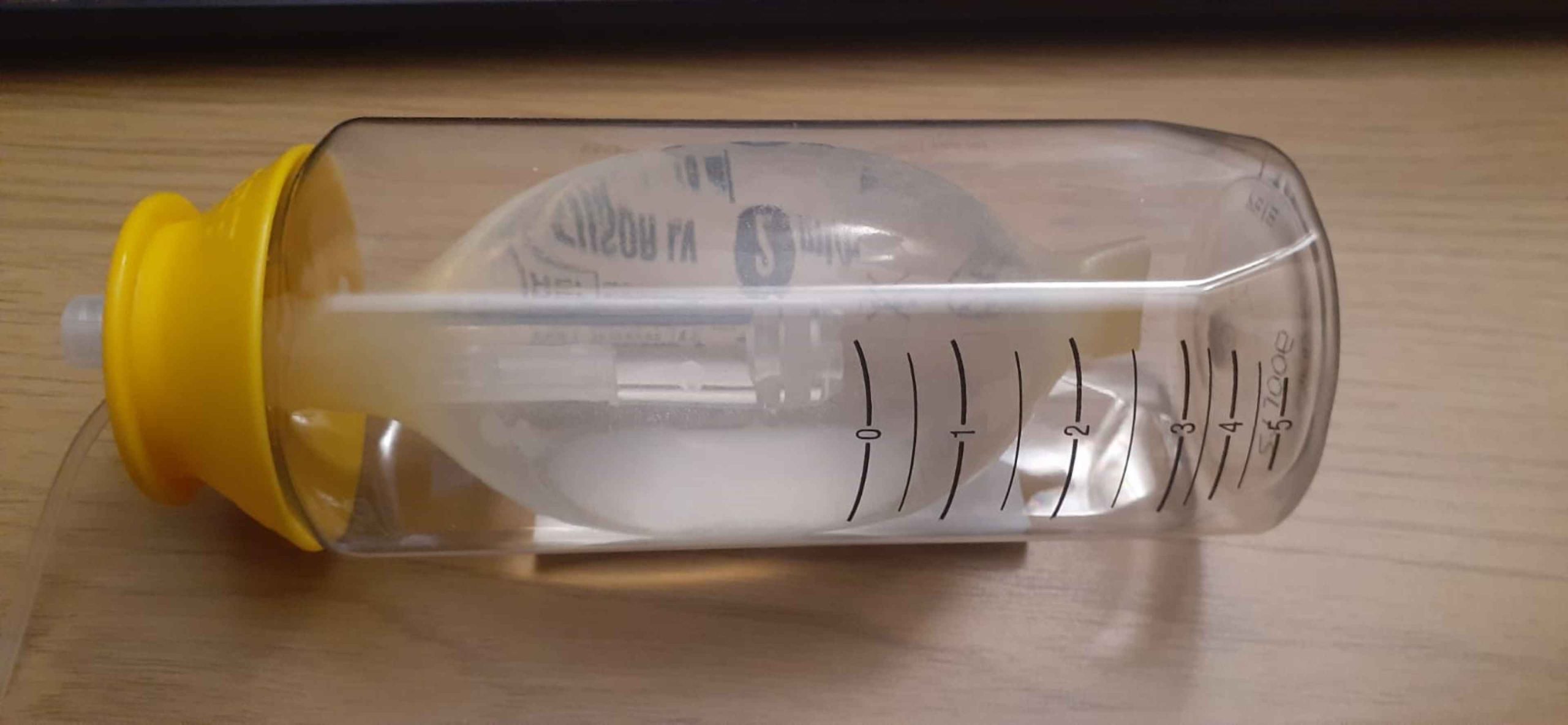
On the fourth day – a community / district nurse comes to me at home – timed as close to the 96 hours (from the previous Monday) and disconnects the pump, flushes my PICC line with saline, changes my PICC dressing and then that’s pretty much it until the next cycle.
The empty Baxter infusor still has to be handled carefully and I’m provided with a special container to hold the pump, which I have to take back to hospital for specialised disposal.
And that’s pretty much how the chemo drugs are administered. Hope it helps someone who might be starting this process and hasn’t bored the remainder of my followers of this blog.
Until the next update of scanxiety and what’s coming next for Wozzer…
Take care and stay safe x